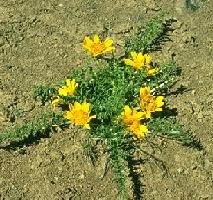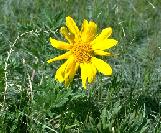

Copyright © 1995 Brother Eric Vogel, St. Mary's College
Hooker's Balsamroot
Balsamorhiza hookeri Nutt.
Perennial with a carrot-like taproot and simple crown. Has large, heart shaped or divided green basal leaves and several leafless flowering stems. incised leaves. Each stem supports a single large head two to four inches across bearing showy outer rays and numerous inner disk flowers. The roots are thick and carrot like, though somewhat woody. Located in dry, rocky outcrops and dry meadows, mainly in the foothills. Found on the Snake River Plain and southeastern Idaho. Blooms from April through July.
Food Use: The root may be eaten raw or cooked. It has a sweet and agreeable taste when cooked. The seed may also be eaten raw or cooked. It can be ground into a powder and formed into cakes for eating raw or made into a bread.
Medicine: A decoction of the root has been used for stomach problems, bladder complaints and female complaints. The sub-species B. hookeri hirsuta has been specified for these uses.
Value for Wildlife:
It is likely that utilization of Hooker balsamroot by wildlife is similar to
use of arrowleaf balsamroot (pronghorn, bighorn sheep, and mule deer). Arrowleaf
balsamroot is grazed year-round but is more palatable during spring and early
summer when the foliage is green.
Planting: Requires a deep fertile well-drained loam in full sun. Plants strongly resent winter wet. Plants are intolerant of root disturbance and should be planted into their permanent positions whilst still small. Division in spring is very difficult, since the plant strongly resents root disturbance. It is probably best to take quite small divisions, or basal cuttings, without disturbing the main clump. Pot these up into individual pots and keep them in light shade in the greenhouse until they are growing away well. Plant them out in the summer if they have grown sufficiently, otherwise over-winter them in the greenhouse and plant out in late spring.
